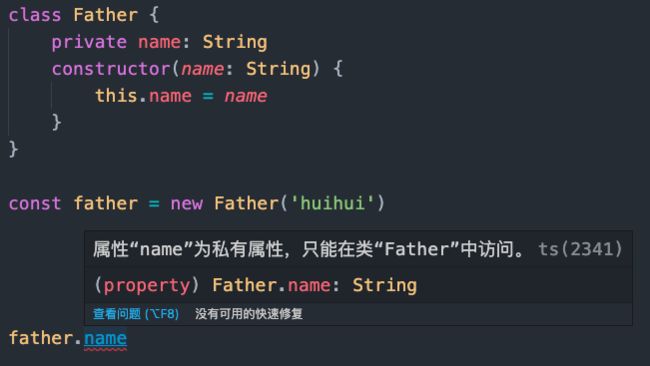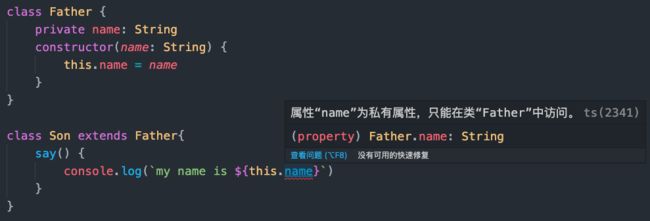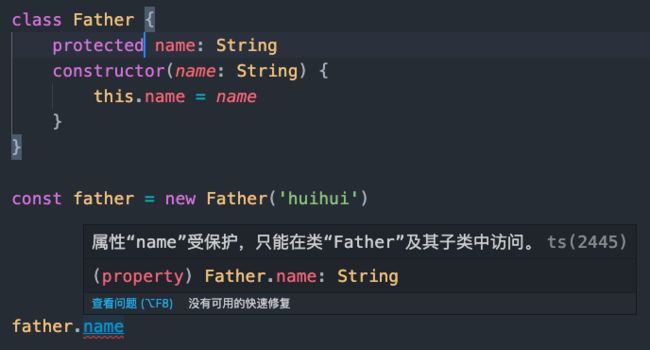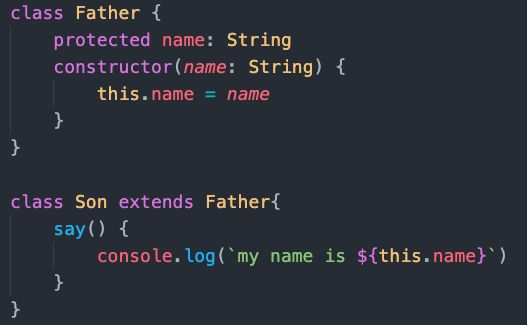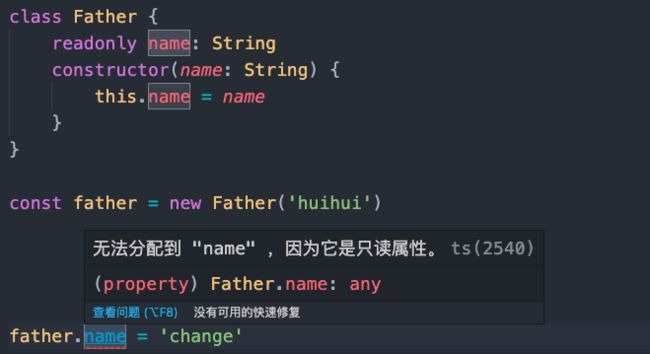TypeScript之类
一、是什么
类(Class)是面向对象程序设计(OOP,Object-Oriented Programming)实现信息封装的基础
类是一种用户定义的引用数据类型,也称类类型
传统的面向对象语言基本都是基于类的,JavaScript 基于原型的方式让开发者多了很多理解成本
在 ES6 之后,JavaScript 拥有了 class 关键字,虽然本质依然是构造函数,但是使用起来已经方便了许多
但是JavaScript 的class依然有一些特性还没有加入,比如修饰符和抽象类
TypeScript 的 class 支持面向对象的所有特性,比如 类、接口等
二、使用方式
定义类的关键字为 class,后面紧跟类名,类可以包含以下几个模块(类的数据成员):
- 字段 : 字段是类里面声明的变量。字段表示对象的有关数据。
- 构造函数: 类实例化时调用,可以为类的对象分配内存。
- 方法: 方法为对象要执行的操作
如下例子:
class Car {
// 字段
engine:string;
// 构造函数
constructor(engine:string) {
this.engine = engine
}
// 方法
disp():void {
console.log("发动机为 : "+this.engine)
}
}
继承
类的继承使用过extends的关键字
class Animal {
move(distanceInMeters: number = 0) {
console.log(`Animal moved ${distanceInMeters}m.`);
}
}
class Dog extends Animal {
bark() {
console.log('Woof! Woof!');
}
}
const dog = new Dog();
dog.bark();
dog.move(10);
dog.bark();
Dog是一个 派生类,它派生自 Animal 基类,派生类通常被称作子类,基类通常被称作 超类
Dog类继承了Animal类,因此实例dog也能够使用Animal类move方法
同样,类继承后,子类可以对父类的方法重新定义,这个过程称之为方法的重写,通过super关键字是对父类的直接引用,该关键字可以引用父类的属性和方法,如下:
class PrinterClass {
doPrint():void {
console.log("父类的 doPrint() 方法。")
}
}
class StringPrinter extends PrinterClass {
doPrint():void {
super.doPrint() // 调用父类的函数
console.log("子类的 doPrint()方法。")
}
}
修饰符
可以看到,上述的形式跟ES6十分的相似,typescript在此基础上添加了三种修饰符:
- 公共 public:可以自由的访问类程序里定义的成员
- 私有 private:只能够在该类的内部进行访问
- 受保护 protect:除了在该类的内部可以访问,还可以在子类中仍然可以访问
#私有修饰符
只能够在该类的内部进行访问,实例对象并不能够访问
并且继承该类的子类并不能访问,如下图所示:
#受保护修饰符
跟私有修饰符很相似,实例对象同样不能访问受保护的属性,如下:
有一点不同的是 protected 成员在子类中仍然可以访问
除了上述修饰符之外,还有只读修饰符
#只读修饰符
通过readonly关键字进行声明,只读属性必须在声明时或构造函数里被初始化,如下:
除了实例属性之外,同样存在静态属性
#静态属性
这些属性存在于类本身上面而不是类的实例上,通过static进行定义,访问这些属性需要通过 类型.静态属性 的这种形式访问,如下所示:
class Square {
static width = '100px'
}
console.log(Square.width) // 100px
1
2
3
4
5
上述的类都能发现一个特点就是,都能够被实例化,在 typescript中,还存在一种抽象类
#抽象类
抽象类做为其它派生类的基类使用,它们一般不会直接被实例化,不同于接口,抽象类可以包含成员的实现细节
abstract关键字是用于定义抽象类和在抽象类内部定义抽象方法,如下所示:
abstract class Animal {
abstract makeSound(): void;
move(): void {
console.log('roaming the earch...');
}
}
1
2
3
4
5
6
这种类并不能被实例化,通常需要我们创建子类去继承,如下:
class Cat extends Animal {
makeSound() {
console.log('miao miao')
}
}
const cat = new Cat()
cat.makeSound() // miao miao
cat.move() // roaming the earch...
三、应用场景
除了日常借助类的特性完成日常业务代码,还可以将类(class)也可以作为接口,尤其在 React 工程中是很常用的,如下:
export default class Carousel extends React.Component {}
由于组件需要传入 props 的类型 Props ,同时有需要设置默认 props 即 defaultProps,这时候更加适合使用class作为接口
先声明一个类,这个类包含组件 props 所需的类型和初始值:
// props的类型
export default class Props {
public children: Array> | React.ReactElement | never[] = []
public speed: number = 500
public height: number = 160
public animation: string = 'easeInOutQuad'
public isAuto: boolean = true
public autoPlayInterval: number = 4500
public afterChange: () => {}
public beforeChange: () => {}
public selesctedColor: string
public showDots: boolean = true
}
当我们需要传入 props 类型的时候直接将 Props 作为接口传入,此时 Props 的作用就是接口,而当需要我们设置defaultProps初始值的时候,我们只需要:
public static defaultProps = new Props()
Props 的实例就是 defaultProps 的初始值,这就是 class作为接口的实际应用,我们用一个 class 起到了接口和设置初始值两个作用,方便统一管理,减少了代码量
